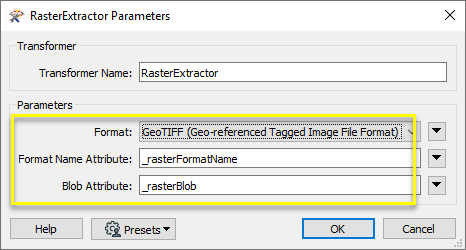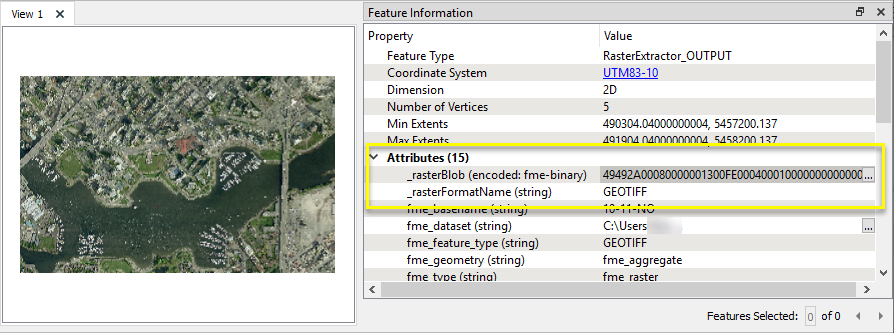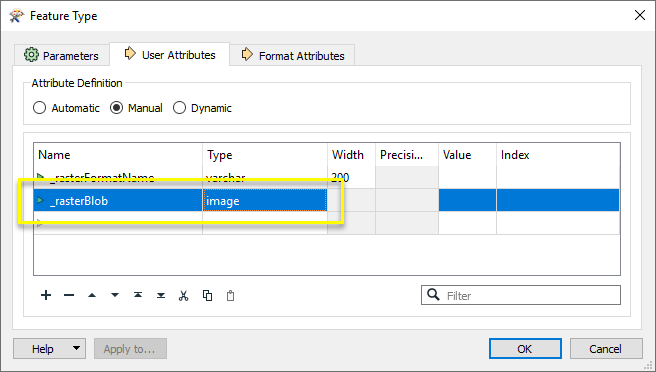RasterExtractor
Serializes the geometry of a raster feature into a Blob attribute, encoding the contents according to a choice of common binary raster formats.
Jump to Configuration
Typical Uses
- Storing rasters in databases that do not support specific raster types but do support Blobs.
- Storing a raster as an attribute of a feature, such as attaching images to vector features.
How does it work?
The RasterExtractor receives raster features and puts a copy of the raster geometry into an attribute, as a Blob - a Binary Large OBject.
The Blob content may be encoded as a variety of common raster formats. The name of the chosen format will also be recorded in an attribute for reference when decoding.
There are no parameters in the transformer to control how the raster is formatted, and encoding is done based on default settings for the chosen format. If necessary, format-specific settings may be overwritten by setting format attributes on the raster feature, prior using the RasterExtractor. For example, if encoding to JPEG, the compression level could be set via the jpeg_compression_level format attribute. Consult the appropriate format’s Writer documentation for a complete list of available attributes.
This transformer is unaffected by raster band and palette selection.
 Example: Writing rasters to a non-spatial database
Example: Writing rasters to a non-spatial database
In this example, we will prepare and write a raster to a Microsoft SQL Server Non-Spatial database, which does not support geometry of any form as an attribute type.
The raster feature is routed into a RasterExtractor, and then on to a Microsoft SQL Server Non-Spatial Writer.

In the parameters dialog, Format is set to GeoTiff, and the Format Name and Blob attributes are left with the default names applied.

Examining the output from the RasterExtractor in the FME Data Inspector, note that the feature has two new attributes - _rasterBlob, containing the encoded raster, and _rasterFormatName, containing the name (GeoTIFF) of the chosen encoding.

In the writer parameters, User Attributes, the Type of _rasterBlob is adjusted to Image, which is a binary field that supports larger values than varbinary, ensuring the data will not be truncated. (Note that the appropriate data type may vary between database formats.)

Usage Notes
- This transformer may be used for writing raster data to a database field. Note that when writing the Raster Blob Attribute, you may need to adjust the attribute type to an unbounded data type to avoid truncation of the data. Choose an appropriate attribute type depending on the destination format (for example, an appropriate attribute type for SQL Server is 'image').
- The RasterReplacer may be used to perform the reverse operation and convert the encoded blob back to the original raster geometry.
- Different encoding formats may carry through different information. For example, GeoTIFF preserves coordinate system and extents, whereas PNG does not.
- To carry out a similar operation on vector data, use the GeometryExtractor transformer. For point cloud data, use the PointCloudExtractor.
- To remove the original geometry after using a RasterExtractor (leaving only the Blob attribute version), use a GeometryRemover.
- The AttributeFileWriter transformer can be used to write the Raster Blob Attribute directly to a file.
Choosing a Raster Transformer
FME has an extensive selection of transformers for working with raster data. They can be generally categorized as working with whole rasters, bands, cells or palettes, and those designed for workflow control or combing raster with vector data.
For information on raster geometry and properties, see Rasters (IFMERaster).
 Raster Transformers
Raster Transformers
Working with Rasters
 These transformers generally apply to whole rasters.
These transformers generally apply to whole rasters.
| RasterCellOriginSetter
|
Sets the cell origin point within cells in a raster.
|
| RasterConvolver
|
Applies a convolution filter (sometimes called a kernel or lens) to raster features and outputs the results.
|
| RasterExpressionEvaluator
|
Evaluates expressions on each cell in a raster or pair of rasters, including algebraic operations and conditional statements.
|
| RasterExtentsCoercer
|
Replaces the geometry of input raster features with a polygon covering either the extents of a raster or the extent of data within a raster.
|
| RasterGCPExtractor
|
Extracts Ground Control Point (GCP) coordinate system and point values from a raster feature and exposes them as attributes.
|
| RasterGCPSetter
|
Sets Ground Control Points (GCPs) on a raster, pairing cell positions with known coordinates.
|
| RasterGeoreferencer
|
Georeferences a raster by either known corner coordinates or origin, cell size, and rotation.
|
| RasterHillshader
|
Generates a grayscale shaded relief representation of terrain, based on elevation values.
|
| RasterInterpretationCoercer
|
Alters the interpretation type of rasters, including all bands, and converts cell values if necessary.
|
| RasterMosaicker
|
Merges multiple raster features into a single raster feature.
|
| RasterPropertyExtractor
|
Extracts the geometry properties of a raster feature and exposes them as attributes.
|
| RasterPyramider
|
Resamples rasters to multiple resolutions, based on either number of levels or dimensions of the smallest output raster. |
| RasterResampler
|
Resamples rasters, based on specified output dimensions, cell size in ground units, or percentage of original, and interpolates new cell values.
|
| RasterRotationApplier
|
Rotates a raster feature according to its rotation angle property, interpolating new cell values, updating all other affected raster properties, and producing an output raster feature with a rotation angle of zero.
|
| RasterSubsetter
|
Clips raster features using pixel bounds instead of ground coordinates, and optionally adds cells around the perimeter.
|
| RasterTiler
|
Splits each input raster into a series of tiles by specifying either a tile size in cells/pixels or the number of tiles.
|
| RasterToPolygonCoercer
|
Creates polygons from input raster features. One polygon is output for each contiguous area of pixels with the same value in the input raster.
|
| WebMapTiler
|
Creates a series of image tiles that can be utilized by web mapping applications such as Bing™ Maps, Google Maps™, or Web Map Tile Service. This is done by resampling rasters to various different resolutions and then splitting them into tiles.
|
Working with Bands
Working with Cells
Working with Palettes
Workflow Control
 These transformers generally control the flow of features in a workspace.
These transformers generally control the flow of features in a workspace.
| RasterCheckpointer
|
Forces accumulated raster operations to be processed, saving the state to disk and releasing resources to tune performance or assist with memory limitations. |
| RasterConsumer
|
Reads raster features for testing purposes, including any accumulated raster operations. No additional operations are performed, and nothing is done with the features. |
| RasterExtractor
|
Serializes the geometry of a raster feature into a Blob attribute, encoding the contents according to a choice of common binary raster formats.
|
| RasterNumericCreator
|
Creates a numeric raster of specified size and resolution, with default cell values.
|
| RasterReplacer
|
Decodes a binary attribute containing encoded rasters stored as Blobs, replacing the feature’s geometry with the decoded raster.
|
| RasterRGBCreator
|
Creates a color raster feature of specified size, resolution, and interpretation type, with default cell values.
|
| RasterSelector
|
Selects specific bands and palettes of a raster for subsequent transformer operations.
|
Vectors and Rasters
 These transformers generally involve using rasters and vector data together.
These transformers generally involve using rasters and vector data together.
| ImageRasterizer
|
Creates a raster representation of vector or point cloud input features, using the fme_color attribute over a solid background fill for vector features. Point clouds may be rendered using their color or intensity components.
|
| NumericRasterizer
|
Creates a numeric raster representation of vector or point cloud input features, where cell values are taken from the z coordinates of the input features and overlaid on a uniform background.
|
| MapnikRasterizer
|
Generates a raster from input vector and raster features, with fine control over symbolization and labeling, using the Mapnik toolkit.
|
| PointOnRasterValueExtractor
|
Extracts the band and palette values from a raster at the location of one or more input points and sets them as attributes on the feature. |
| RasterDEMGenerator
|
Produces a raster digital elevation model (DEM) by uniformly sampling a Delaunay triangulation generated from input points and breaklines. |
| VectorOnRasterOverlayer
|
Rasterizes vector or point cloud features onto an existing raster. For vector features the fme_color attribute sets pixel color, and point clouds may be rendered using their color or intensity components.
|
Configuration
Input Ports
 Input
Input
This transformer accepts only raster features.
Output Ports
 Output
Output
Raster features with their geometry also encoded as an attribute as specified.
 <Rejected>
<Rejected>
Non-raster features will be routed to the <Rejected> port, as well as invalid rasters.
Rejected features will have an fme_rejection_code attribute with one of the following values:
INVALID_FEATURE_CANNOT_WRITE
Rejected Feature Handling: can be set to either terminate the translation or continue running when it encounters a rejected feature. This setting is available both as a default FME option and as a workspace parameter.
Parameters
 Parameters
Parameters
| Format
|
The raster format used to encode the blob. Choices include:
- GeoTIFF
- TIFF
- BMP
- JPEG
- JPEG 2000
- GIF
- PNG
- SGI
|
| Format Name Attribute
|
Name the attribute to contain the selected Format name.
|
| Blob Attribute
|
Name the attribute to contain the encoded Blob.
|
Editing Transformer Parameters
Using a set of menu options, transformer parameters can be assigned by referencing other elements in the workspace. More advanced functions, such as an advanced editor and an arithmetic editor, are also available in some transformers. To access a menu of these options, click  beside the applicable parameter. For more information, see Transformer Parameter Menu Options.
beside the applicable parameter. For more information, see Transformer Parameter Menu Options.
Defining Values
There are several ways to define a value for use in a Transformer. The simplest is to simply type in a value or string, which can include functions of various types such as attribute references, math and string functions, and workspace parameters. There are a number of tools and shortcuts that can assist in constructing values, generally available from the drop-down context menu adjacent to the value field.
 How to Set Parameter Values
How to Set Parameter Values
Using the Text Editor
The Text Editor provides a convenient way to construct text strings (including regular expressions) from various data sources, such as attributes, parameters, and constants, where the result is used directly inside a parameter.
Text Editor
Using the Arithmetic Editor
The Arithmetic Editor provides a convenient way to construct math expressions from various data sources, such as attributes, parameters, and feature functions, where the result is used directly inside a parameter.
Arithmetic Editor
Conditional Values
Set values depending on one or more test conditions that either pass or fail.
Parameter Condition Definition Dialog
Content
Expressions and strings can include a number of functions, characters, parameters, and more - whether entered directly in a parameter or constructed using one of the editors.
Reference
|
Processing Behavior
|
Feature-Based
|
|
Feature Holding
|
No
|
| Dependencies |
None |
|
FME Licensing Level
|
FME Professional Edition and above
|
| Aliases |
|
| History |
|
| Categories |
Rasters
|
FME Community
The FME Community is the place for demos, how-tos, articles, FAQs, and more. Get answers to your questions, learn from other users, and suggest, vote, and comment on new features.
Search for all results about the RasterExtractor on the FME Community.
Examples may contain information licensed under the Open Government Licence – Vancouver




 beside the applicable parameter. For more information, see
beside the applicable parameter. For more information, see